ML Aggarwal Class 7 Solutions Chapter 15 Visualising Solid Shapes Objective Type Questions for ICSE Understanding Mathematics acts as the best resource during your learning and helps you score well in your exams.
ML Aggarwal Class 7 Solutions for ICSE Maths Chapter 15 Visualising Solid Shapes Objective Type Questions
Mental Maths
Question 1.
Fill in the blanks:
(i) A solid having no vertex and no edge is a ………..
(ii) A solid that has congruent and parallel polygons as top and bottom faces and all other faces rectangular is known as ………
(iii) A pyramid having 4 equilateral triangles as its faces is known as ………
(iv) A solid having 3 faces (one curved and two circulars), no vertex and two curved edges are known as ……..
(v) A solid having a circular base and one vertex is called a ………
(vi) A triangular prism has ……… faces, ………… edges and ………. vertices.
(vii) A triangular pyramid has ……… faces, ………. edges and ……… vertices.
(viii) A square pyramid has ……… faces, ……….. edges and ……… vertices.
(ix) The base of a triangular pyramid is a ………
(x) Out of ……….. faces of a triangular prism, ……… are rectangle and ……….. are triangles.
(xi) Out of ……….. faces of a square pyramid, ………. are a triangle and ………. is/are squares.
(xii) Out of ………. faces of a rectangular pyramid, ………. are triangles and the base is a ……….
(xiii) A ……….. is a sort of skeleton – outline in 2-D, which on folding results in a 3-D shape.
(xiv) If the sum of numbers on the two dice thrown together is 9, then the sum of the numbers opposite to these faces is ……….
Solution:
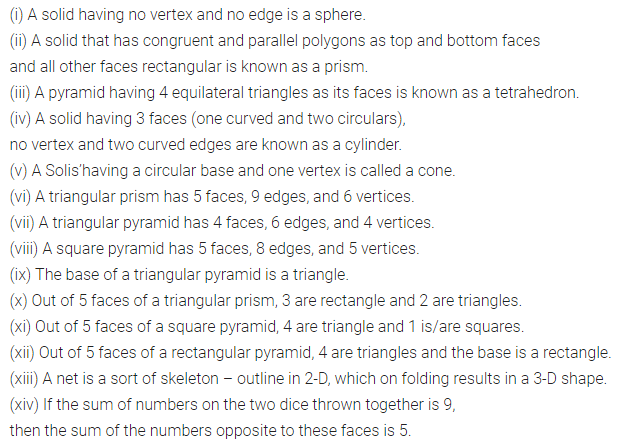
Question 2.
State whether the following statements are true (T) or false (F):
(i) The faces of a prism are triangular.
(ii) A cube can be treated as a prism.
(iii) A pyramid has only one vertex.
(iv) All the faces, except the base, of a square pyramid are triangular.
(v) A tetrahedron has 3 rectangular faces and 1 rectangle face.
(vi) A square pyramid has 5 faces and one vertex.
(vii) A cone has one vertex, two faces, and one curved edge.
(viii)The shadow of a 3-D object is a 2-D figure.
(ix) A cube can cast a shadow in the shape of a rectangle.
(x) A cube can cast a shadow in the shape of a hexagon.
(xi) In an isometric sketch, the line segments of different lengths can represent the sides of a cube.
(xii) In an oblique sketch of a cuboid, the size of the opposite faces must be different.
(xiii) The top, front and side views of a sphere are different.
(xiv) The adjoining net is of a hexagonal pyramid.

Solution:
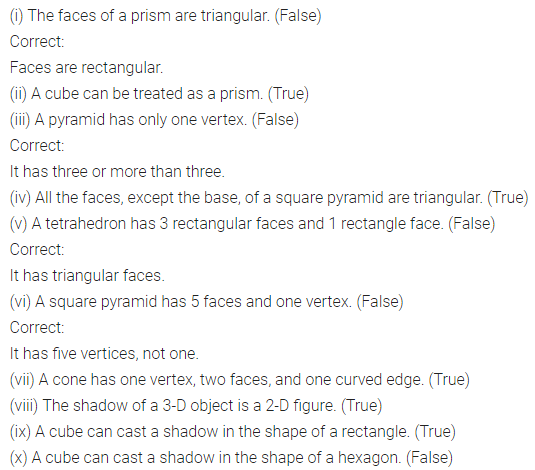
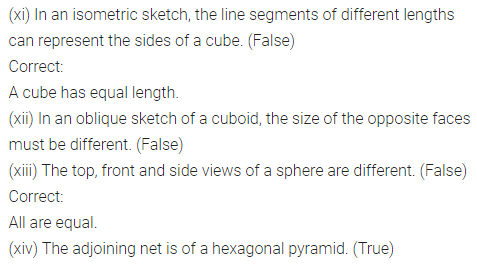
Multiple Choice Questions
Choose the correct answer from the given four options (3 to 11):
Question 3.
A triangular prism has
(a) 4 vertices and 6 edges
(b) 6 vertices and 9 edges
(c) 6 vertices and 6 edges
(d) 9 vertices and 6 edges
Solution:
![]()
Question 4.
A square pyramid has
(a) 4 vertices and 4 faces
(b) 4 vertices and 5 faces
(c) 5 vertices and 4 faces
(d) 5 vertices and 5 faces
Solution:
![]()
Question 5.
A solid having 4 (plane) faces, 4 vertices and 6 edges is called a
(a) triangular prims
(b) rectangular prism
(c) triangular pyramid
(d) rectangular pyramid
Solution:

Question 6.
The number of cubes in the given structure is
(a) 12
(b) 10
(c) 9
(d) 8
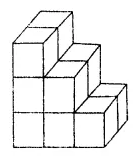
Solution:
![]()
Question 7.
An isometric sheet is made up of dots forming
(a) squares
(b) rectangles
(c) right-angled triangles
(d) equilateral triangles
Solution:

Question numbers 8 to 11 are based on the given figure in which unit cubes are put together to form a structure as shown:
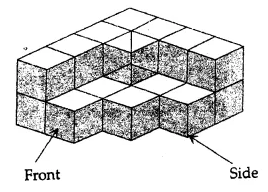
Question 8.
The number of unit cubes in the given structure is
(a) 13
(b) 20
(c) 21
(d) 22
Solution:
![]()
Question 9.
The number of unit cubes to be added to make a cuboid of dimensions 4 unit × 4 unit × 2 unit is
(a) 11
(b) 12
(c) 13
(d) 14
Solution:

Question 10.
If the structure is painted on the surface everywhere, then the number of unit cubes having no face painted is
(a) 0
(b) 1
(c) 2
(d) 11
Solution:

Question 11.
The side view of the given structure is

Solution:
![]()